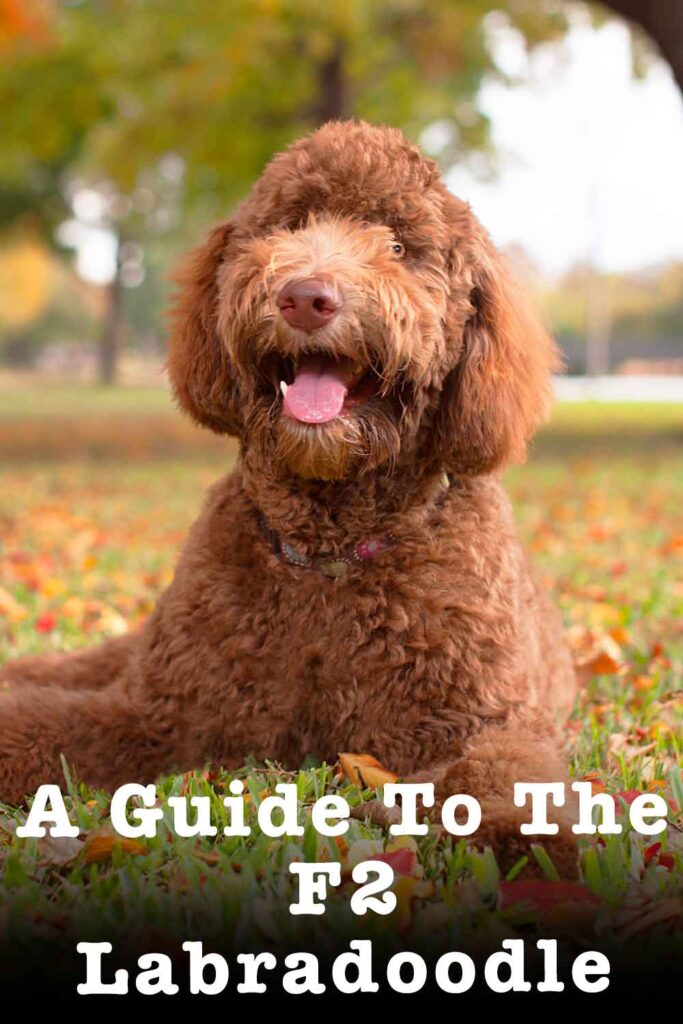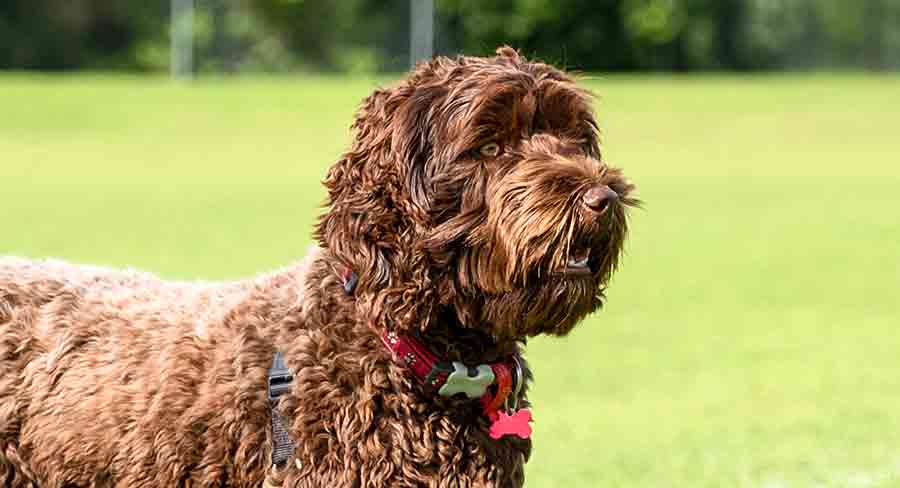What is an f2 Labradoodle?
F2 is shorthand for ‘second filial generation’. It means that a Labradoodle is two generations removed from their closest purebred ancestors.
In other words, their parents were first generation Labradoodles, and their grandparents were Labradors and Poodles.
The ancestry of a Labradoodle puppy can provide important information about their temperament, coat, etc.
But you don’t need an advanced degree to understand it!
We’ll break down the basics of genetics and inheritance, and what it all means when you are choosing a Labradoodle puppy.
Labradoodle Ancestry
Labradoodles are sometimes described as ‘designer dogs’. They are the result of planned breeding between Poodles (Standard or Miniature) and Labrador Retrievers.
You might think that most Labradoodles available from breeders are first generation, but this is often not the case.
Even other dog breeds are sometimes added to Labradoodle breeding lines.
This is especially true of the dogs known as Australian Labradoodles, which have breeds like the Cocker Spaniel in the mix.
To simplify our look at f2 Labradoodles, we’ll stick to Poodles and Labs as the main parent breeds for the purposes of this article.
Let’s start with the first step on the way to producing an F2 Labradoodle, and that’s breeding F1 Labradoodles.
f1 Labradoodles
When a Labrador Retriever and a Poodle mate, the first generation of puppies is known as the first filial generation (f1).
f1 Labradoodles are half-Lab and half-Poodle in their genetic makeup.
An f1 Labradoodle inherits traits from each of their parents at random. They might have a curly, non-shedding coat, or a straight, heavy-shedding coat, for example.
Due to this unpredictability, f1 dogs are sometimes just a breeders’ first step towards creating a line of breeding stock that reliably carries desirable Labradoodle characteristics from generation to generation.
Such as a non-shedding coat, and a confident, sociable disposition.
f1b Labradoodles
To increase the odds of a Labradoodle inheriting a trait more closely associated with either Labs or Poodles, f1 dogs are sometimes bred back to pedigree Labs or Poodles.
This create a generation called f1b Labradoodles, which are approximately 75% one breed, and 25% the other.
f1b Labradoodles from a Labradoodle and a Poodle will be more likely to inherit a non-shedding coat, for example. And f1b Labradoodles from a Labradoodle and a Labrador may be more outgoing, or adept at field work.
This is why f1b backcrossing is a common step in Labradoodle breeding.
Now that we’ve covered the basics of the first filial generations of Labradoodles, let’s look at f2 Labradoodles.
f2 Labradoodles
Their closest pedigree ancestor of an f2 Labradoodle is no longer a parent, but a grandparent – the ‘2’ stands for two degrees of separation.
At least one of their parents belongs to the f1 generation described above.

f2 Labradoodles can achieved by any of the following breeding combinations:
- f1 x f1
- f1 x f1b
- f1b x f1b
- f1 x f2
- f1 x f3
But some of these possibilities are more popular than others among Labradoodle breeders.
For example, using two f1 dogs will produce an f2 litter with vary variable characteristics. They will still be 50% Lab and 50% Poodle on average, but the exact genes they inherit from each breed will differ from pup to pup.
Meanwhile, using an f1b sire (dad) or dam (mom) to produce an f2 generation increases the probability of the puppies having typically Poodle or Labrador traits, depending on the parentage of the f1b dog.
But if that’s so desirable, why not go even further, and breed an f2 generation with a purebred Poodle parent?
Well, some breeders do!
f2b Labradoodles
An f2 Labradoodle bred back to a purebred Poodle or pedigree Labrador is an f2b Labradoodle.
Genetically, they may even closer to one of their purebred ancestors than an F1b Labradoodle.
Which means they’re even more likely to have traits of one breed, but commensurately less likely to have traits of the other.
It’s a balancing act that breeders should take seriously, rather than picking parent dogs at random.
It’s also why it’s important to find out from a breeder exactly what the ancestry of any Labradoodle litter is. And not to assume that each f2b litter you meet will be the same in looks and temperament as the last.
Confusion and inconsistency
Unfortunately, there’s a lot of inconsistent advice around how to use terms like f1b, f2 and f2b.
For example, different breeders may describe an f1 x f1b cross as either f2, or f2b.
On the one hand, this inconsistency is confusing.
But other other, the numbers are pretty meaningless anyway, without knowing exactly what mating decisions were made and why.
So rather than feeling overwhelmed by the labels, ask breeders to talk you through their puppies’ family tree. Reputable breeders often own several generations of the same family, and love to talk about the amazing qualities each sire and dam had which made them special enough to use for breeding.
A good breeder will also be able to tell you roughly what proportion of of Labrador and Poodle DNA a litter will have, and how they hope the breeding choices they’ve made will shape the physical and mental characteristics of their puppies.
They should also be candid though, that crossbreeding carries an unavoidable degree of unpredictability. And if you particularly want, say, a non-shedding coat, a good breeder will be honest with you about the odds of their puppies having one, and the potential for disappointment.
Next, let’s look at what comes after f2 Labradoodles.
f2 and beyond: multi-generation Labradoodles
Using the ‘f’ system to denote filial generations is a simple counting system. So you may see references to f3 Labradoodles, f4 Labradoodles, and beyond.
An f3 Labradoodle is the third filial generation: it means a Labradoodle’s closest pedigree ancestor is a great-grandparent.
Some breeders refer to f3 dogs, but you rarely see the “f” designation beyond f3.
Subsequent generations of Labradoodles are usually called multi-generation, or multi-gen, dogs.
This is partly because later generations are often thought of as having more stable and uniform genetic traits. So an ‘f’ label stops providing information about how variable puppies are likely to be.
It’s also partly because there’s no official need to keep counting. Compare this to wolf-dog hybrids and wild cat hybrids, which are frequently subject to licensing and regulation until f6.
And finally, because it just gets a bit complicated to keep track of, without any pressing need to!
Choosing an f2 Labradoodle
So what type of Labradoodle should you look for? Are you interested in an early generation pup, or multi-gen dog?
Labradoodles can vary widely from one breeder to another. Let’s look at a few factors that can influence your choice.
Labradoodles are known for their soft curly coats. Many potential Doodle owners are also seeking a dog that is low shedding and hypoallergenic.
These coat characteristics are more like the Poodle’s than the Labrador Retriever’s. But keep in mind that no dog can ever be 100% hypoallergenic.
Coat preference is why many Doodle experts recommend that you do not choose a first- or second-generation Labradoodle. This physical trait is reproduced more reliably in multi-gen dogs.
However, for many other characteristics, such as intelligence, loyalty, and trainability, you can find both Labradors and Poodles who have these qualities in spades.
So an f2 Labradoodle might still be your ideal pet, if the parents are right.
Choosing the right f2 Labradoodle breeder
It’s important to work with a breeder who shares ancestry and all other relevant information with you.
Besides ancestry, a reputable breeder should provide you with:
- Genetic screening test results (for inherited conditions like hip dysplasia)
- Veterinary health check and vaccination records
- Photos of previous litters
- References from other clients
- A health guarantee and a contract
- The opportunity to tour the home/kennel and see the mother, father (if possible), and littermates.
f2 Labradoodle – summary
f2 Labradoodles’ closest purebred relations belong to their grandparents’ generation.
f2 Labradoodles can be variable in terms of looks, coat, temperament and behavior.
But they’re an important stepping stone on the way to multi-gen Labradoodles.
f2 Labradoodles can also be great pets in their own right. Choosing a good breeder improves the odds of you being happy with the dog you bring home.
Do you have an f2 Labradoodle?
Tell us about them in the comments box!

